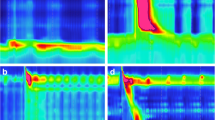Abstract
Background: It has been postulated that nonsurgical treatments for achalasia cause fibrosis, increasing the risk of surgical Heller myotomy. The goal of this study was to evaluate fibrosis, muscle fracture, and esophageal inflammation after these treatments. Methods: Eighteen female swine were divided into three groups: 6 were euthanized and their lower esophageal sphincters were harvested (group 1); 6 underwent botulinum toxin injection (group 2); and 6 underwent forced balloon dilatation (group 3). Groups 2 and 3 were euthanized 30 days later and LESs harvested. LESs, were evaluated with trichrome and hematoxylin and eosin (H&E) preparations. Results: Results for both trichrome and H&E slides were the same: severe inflammation in groups 2 and 3 but only minimal inflammation in group 1 (p < 0.05) and mild fibrosis in groups 2 and 3 and none in group 1 (p < 0.05). Conclusions: Botulinum toxin injection and forced balloon dilatation caused significant inflammation in the esophagus of the swine, which would be consistent with the injury caused by reflux. Forced balloon dilatation and botulinum toxin caused fibrosis and may increase surgical risk.
Similar content being viewed by others
References
IJ Beckingham M Callanan JA Louw PC Bornman (1999) ArticleTitleLaparoscopic cardiomyotomy for achalasia after failed balloon dilatation. Surg Endosc 13 493–496 Occurrence Handle10.1007/s004649901020 Occurrence Handle1:STN:280:DyaK1M3ksVOmtw%3D%3D Occurrence Handle10227950
M Bloomston F Serafini AS Rosemurgy (2001) ArticleTitleVideoscopic Heller myotomy as first-line therapy for severe achalasia. Am Surg 67 1105–1109 Occurrence Handle1:STN:280:DC%2BD3MnosVaksQ%3D%3D Occurrence Handle11730231
A Csendes I Braghetto A Henriquez C Cortes (1989) ArticleTitleLate results of a prospective randomised study comparing forceful dilatation and oesophagomyotomy in patients with achalasia. Gut 30 299–304 Occurrence Handle1:STN:280:BiaB3M3hs1I%3D Occurrence Handle2651226
JR Goldblum RI Whyte MB Orringer HD Appelman (1994) ArticleTitleAchalasia. A morphologic study of 42 resected specimens. Am J Surg Pathol 18 327–337 Occurrence Handle1:STN:280:ByuC1cboslw%3D Occurrence Handle8141427
S Horgan K Hudda T Eubanks J McAllister CA Pellegrim (1999) ArticleTitleDoes botulinum toxin injection make esophagomyotomy a more difficult operation? Surg Endosc 13 576–579 Occurrence Handle10.1007/s004649901044 Occurrence Handle1:STN:280:DyaK1M3nvVGnsg%3D%3D Occurrence Handle10347294
JG Hunter WS Richardson (1997) ArticleTitleSurgical management of achalasia. Surg Clin North Am 77 993–1015 Occurrence Handle1:STN:280:DyaK1c%2FgslGiug%3D%3D Occurrence Handle9347828
SC Kadakia RK Wong (2001) ArticleTitlePneumatic balloon dilation for esophageal achalasia. Gastrointest Endosc Clin North Am 11 325–346 Occurrence Handle1:STN:280:DC%2BD3M3jtFaisg%3D%3D
R Panaccione JC Gregor RP Reynolds HG Preiksaitis (1999) ArticleTitleIntrasphincteric botulinum toxin versus pneumatic dilatation for achalasia: a cost minimization analysis. Gastrointest Endosc 50 492–498 Occurrence Handle1:STN:280:DyaK1MvjtF2gtA%3D%3D Occurrence Handle10502169
PJ Pasricha R Rai WJ Ravich TR Hendrix AN Kalloo (1996) ArticleTitleBotulinum toxin for achalasia: long-term outcome and predictors of response. Gastroenterology 110 1410–1405 Occurrence Handle1:CAS:528:DyaK28XjtV2htL4%3D Occurrence Handle8613045
PJ Pasricha WJ Ravich TR Hendrix S Sostre B Jones AN Kalloo (1995) ArticleTitleIntrasphincteric botulinum toxin for the treatment of achalasia. N Engl J Med 332 774–778 Occurrence Handle10.1056/NEJM199503233321203 Occurrence Handle1:STN:280:ByqC28nislI%3D Occurrence Handle7862180
TD Schiano RS Fisher HP Parkman S Cohen M Dabezies LS Miller (1996) ArticleTitleUse of high-resolution endoscopic ultrasonography to assess esophageal wall damage after pneumatic dilation botulinum toxin injection to treat achalasia. Gastrointest Endosc 44 151–157 Occurrence Handle1:STN:280:ByiD3M7jtFQ%3D Occurrence Handle8858320
CF Torbey E Achkar TW Rice M Baker JE Richter (1999) ArticleTitleLong-term outcome of achalasia treatment: the need for closer follow-up. J Clin Gastroenterol 28 125–130
DR Urbach PD Hansen YS Khajanchee LL Swanstrom (2001) ArticleTitleA decision analysis of the optimal initial approach to achalasia: laparoscopic Heller myotomy with partial fundoplication, thoracoscopic Heller myotomy, pneumatic dilatation, or botulinum toxin injection. J Gastrointest Surg 5 192–205 Occurrence Handle10.1016/S1091-255X(01)80033-0 Occurrence Handle1:STN:280:DC%2BD3Mzjt1Cksg%3D%3D Occurrence Handle11331483
G Vantrappen J Hellemans W Deloof P Valembois J Vandebroucke (1971) ArticleTitleTreatment of achalasia with pneumatic dilatations. Gut 12 268–275 Occurrence Handle1:STN:280:CS6C1cnnsVA%3D Occurrence Handle5574797
T Wehrmann V Jacobi M Jung B Lembcke WF Caspary (1995) ArticleTitlePneumatic dilation in achalasia with a low-compliance balloon: results of a 5-year prospective evaluation. Gastrointest Endosc 42 31–36 Occurrence Handle1:STN:280:BymD38vgtl0%3D Occurrence Handle7557173
Acknowledgements
This work was funded by a SAGES research grant.
Author information
Authors and Affiliations
Corresponding author
Rights and permissions
About this article
Cite this article
Richardson, W., Willis, G. & Smith, J. Evaluation of scar formation after botulinum toxin injection or Forced balloon dilation to the lower esophageal sphincter . Surg Endosc 17, 696–698 (2003). https://doi.org/10.1007/s00464-002-8628-x
Received:
Accepted:
Published:
Issue Date:
DOI: https://doi.org/10.1007/s00464-002-8628-x




